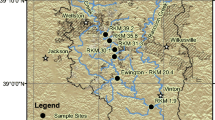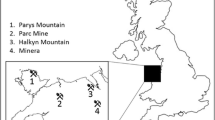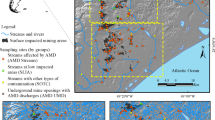Abstract
A synoptic water quality study was implemented in Warden Gulch, a headwater stream affected by metals that are contributed by both natural and mining-impacted sources. Warden Gulch is a tributary to Peru Creek (Colorado, USA), where emplacement of a mine tunnel bulkhead and other remedial actions have improved water quality upstream of Warden Gulch. The goal of this study was to identify individual source contributions to Warden Gulch and determine if additional remedial actions were warranted. To this end, trace metal loading was quantified from various sources including an actively draining mine. Although highly concentrated waste streams from mining-impacted sites degrade water quality, natural contributions from unmined areas within the Warden Gulch watershed are the dominant sources of metal loading. Further, some mining-impacted sources are associated with diffuse groundwater inflows that may not be amenable to clean up, due to the diffuse nature of the sources and the associated cost. Mining-impacted sources that are amenable to clean up may therefore represent a small portion of the overall metal loading to Warden Gulch. Remedial measures directed at these sources may not substantially improve the water quality of Peru Creek and the larger Snake River watershed.
Zusammenfassung
Eine synoptische Wasserqualitätsstudie wurde im Warden Gulch durchgeführt, einem Quellfluss, der durch Metalle belastet ist, die sowohl aus natürlichen als auch aus bergbaubedingten Quellen stammen. Warden Gulch ist ein Nebenfluss des Peru Creek (Colorado, USA), in dem die Wasserqualität stromoberhalb der Einmündung durch die Errichtung eines Stollenschotts und andere Sanierungsmaßnahmen verbessert werden konnte. Ziel dieser Studie war es, die Beiträge einzelner Quellen zum Warden Gulch zu ermitteln und festzustellen, ob zusätzliche Sanierungsmaßnahmen erforderlich sind. Zu diesem Zweck wurde die Belastung mit Spurenmetallen aus verschiedenen Quellen, einschließlich einer aktiv entwässernden Mine, quantifiziert. Obwohl hochkonzentrierte Abfallströme aus bergbaubedingten Standorten die Wasserqualität verschlechtern, sind natürliche Beiträge aus nicht bergbaubedingten Gebieten innerhalb des Wassereinzugsgebiets des Warden Gulch die wichtigsten Quellen für die Metallbelastung. Darüber hinaus sind einige bergbaubedingte Quellen mit diffusen Grundwasserzuflüssen verbunden, die aufgrund ihres diffusen Charakters und der damit verbundenen Kosten möglicherweise nicht gereinigt werden können. Bergbaubedingte Quellen, die einer Sanierung zugänglich sind, können daher nur einen kleinen Teil der Gesamtmetallbelastung des Warden Gulch ausmachen. Abhilfemaßnahmen, die auf diese Quellen abzielen, können die Wasserqualität des Peru Creek und des größeren Wassereinzugsgebiets des Snake River nicht wesentlich verbessern.
Resumen
Se presenta un estudio sintético sobre la calidad del agua en un arroyo de cabecera de cuenca (Warden Gulch) cuyo contenido en metales es debido tanto a fuentes naturales como a efectos derivados de actividades mineras. El arroyo Warden Gulch es un afluente del río Peru Creek (Colorado, EE.UU.) en el cual la calidad del agua ha sido mejorada aguas arriba del arroyo Warden Gulch mediante la ejecución de diques en las galerías de las minas, entre otras medidas correctoras. El objetivo de este estudio era identificar las fuentes individuales que contribuyen a la carga metálica del arroyo Warden Gulch y determinar la necesidad o no de medidas correctoras adicionales. Para ello, se cuantificó la concentración de elementos traza procedentes de diversas fuentes, incluido el drenaje directo de una mina. Aunque los lixiviados de las zonas afectadas por minería presentan elevadas concentraciones de metales y degradan la calidad del agua, en el caso de la cuenca de Warden Gulch, las contribuciones naturales de las zonas no minadas constituyen las fuentes dominantes de carga de metales. Además, algunas de las fuentes de contaminantes asociadas con actividades mineras están relacionadas con flujos difusos de agua subterránea y pueden no ser susceptibles de remediación, debido tanto a la naturaleza difusa de las fuentes como al coste económico asociado. Las fuentes de metales asociadas a actividades mineras que son susceptibles de remediar representan una pequeña parte de la carga total metálica del arroyo Warden Gulch. De esta forma, es previsible que las medidas correctoras dirigidas a remediar estas fuentes no mejoren sustancialmente la calidad del agua de los ríos Peru Creek y Snake (receptor del aguas del primero).
摘要
我们在Warden Gulch河进行了一项日常水质研究, 该河是一条源头溪流, 其受到自然来源和采矿作业来源金属元素的影响。Warden Gulch河是Peru Creek河 (位于美国科罗拉多州) 的支流, 在Peru Creek河设置了矿井巷道隔离壁, 并采取了其他修复措施后, 改善了Warden Gulch河上游的水质。本项研究的目的是确定个别水体来源对Warden Gulch河的影响, 并确定是否需要采取额外的修复措施。为此, 对包括一个**在进行排水的矿井在内的各种来源的微量金属元素含量进行了化验。虽然来自采矿影响区的高浓度废水会降低水质, 但金属元素的主要来源是Warden Gulch河流域未开采区域内的自然环境。此外, 一些受采矿作业来源的金属元素与扩散的地下水流入有关, 由于金属元素来源的扩散性质和相关成本, 金属元素可能无法进行清理。因此, 易于清理的采矿作业来源的金属元素可能只占Warden Gulch河总金属元素总量的一小部分。针对这些来源的修复措施可能不会显著改善Peru Creek河以及更大的Snake河流域的水质。







Similar content being viewed by others
References
Alpers CN, Nordstrom DK (2000) Estimation of pre-mining conditions for trace metal mobility in mineralized areas: an overview. In: Proc, 5th International Conf on Acid Rock Drainage, vol 1, pp 463–472
Bencala KE, McKnight DM (1987) Identifying in-stream variability: sampling iron in an acidic stream. In: Averett RC, McKnight DM (eds) Chemical quality of water and the hydrologic cycle. Lewis Publishers, Chelsea, pp 255–269
Bencala KE, McKnight DM, Zellweger GW (1987) Evaluation of natural tracers in an acidic and metal-rich stream. Water Resour Res 23(5):827–836. https://doi.org/10.1029/WR023i005p00827
Carroll JE (2017) Dynamics of solute transport and rare earth element behavior in acid mine drainage impacted alpine rivers, Snake River Co. MS Thesis, Univ of Colorado at Boulder
CDPHE (Colorado Department of Public Health and Environment) (2008) Total maximum daily load assessment: Snake River and Peru Creek, Summit County Colorado. State of Colorado Water Quality Control Division
CDPHE (2017) Colorado abandoned mines water quality study
CDPHE (2021a) Regulation No. 93, Colorado’s Section 303 (d) List of impaired waters and monitoring and evaluation list (5 CCR 1002-93), as amended on June 15, 2021a
CDPHE (2021b) Regulation No. 31, the basic standards and methodologies for surface water (5 CCR 1002-31), as amended on Aug. 9, 2021b
Chapin CE (2012) Origin of the Colorado mineral belt. Geosphere 8(1):28–43. https://doi.org/10.1130/GES00694.1
Crouch CM, McKnight DM, Todd AS (2013) Quantifying sources of increasing zinc from acid rock drainage in an alpine catchment under a changing hydrologic regime. Hydrol Process 27(5):721–733. https://doi.org/10.1002/hyp.9650
Duren S (2004) Quantitative hydrologic evaluation of dissolved metal loading and transport in Peru Creek, an acid rock drainage stream: Summit County, Colorado. PhD Diss, Univ of Colorado at Boulder
Grayson RB, Gippel CJ, Finlayson BL, Hart BT (1997) Catchment-wide impacts on water quality: the use of ‘snapshot’ sampling during stable flow. J Hydrol 199(1–2):121–134. https://doi.org/10.1016/S0022-1694(96)03275-1
Gustavson KE, Barnthouse LW, Brierley CL, Clark EH II, Ward CH (2007) Superfund and mining megasites. Environ Sci Technol 41:2667–2672. https://doi.org/10.1021/es0725091
Jones MM (2020) Quantification of trace metal loading within a mineralized watershed and a changing climate, Warden Gulch, Summit County, Colorado. MS thesis, Univ of Colorado at Boulder
Keystone Policy Center (2020) Snake River Watershed Task Force (Colorado) points to successful collaborative model for abandoned mine reclamation. http://www.keystone.org/wp-content/uploads/2020/12/SRWTF-Final-CaseStudy.v2.pdf
Kilpatrick FA, Cobb ED (1985) Measurement of discharge using tracers. Techniques of water-resources investigations, book 3, ch A16, USGS, Dept of the Interior, https://pubs.usgs.gov/twri/twri3-a16/
Kimball BA, Runkel RL, Walton-Day K, Bencala KE (2002) Assessment of metal loads in watersheds affected by acid mine drainage by using tracer injection and synoptic sampling: Cement Creek, Colorado, USA. Appl Geochem 17(9):1183–1207. https://doi.org/10.1016/S0883-2927(02)00017-3
Li P (2018) Mine water problems and solutions in China. Mine Water Environ 37:217–221. https://doi.org/10.1007/s10230-018-0543-z
Lovering TS (1935) Geology and ore deposits of the Montezuma Quadrangle, Colorado. USGS Professional Paper 178, US Dept of the Interior. https://pubs.er.usgs.gov/publication
Mast MA, Verplanck PL, Wright WG, Bove DJ (2007) Characterization of background water quality (Chapter E7). In: Church SE, von Guerard P, Finger SE (eds) Integrated investigations of environmental effects of historical mining in the Animas River watershed. San Juan County, Colorado. USGS, Professional Paper 1651, US Dept of the Interior, pp 417–495. http://pubs.usgs.gov/pp/1651
McKnight DM, Bencala KE (1990) The chemistry of iron, aluminium, and dissolved organic material in three acidic, metal-enriched, mountain streams, as controlled by watershed and in-stream processes. Water Resour Res 26(12):3087–3100. https://doi.org/10.1029/WR026i012p03087
Nordstrom DK (2009) Acid rock drainage and climate change. J Geochem Explor 100(2–3):97–104. https://doi.org/10.1016/j.gexplo.2008.08.002
Nordstrom DK (2011) Hydrogeochemical processes governing the origin, transport and fate of major and trace elements from mine wastes and mineralized rock to surface waters. Appl Geochem 26(11):1777–1791. https://doi.org/10.1016/j.apgeochem.2011.06.002
O’Shea H (2007) Backward modeling to prioritize sources of acid mine drainage for remediation: application to Warden Gulch, Summit County, Colorado. MS thesis, Univ of Colorado at Boulder
Petach TN (2022) Remediation of acid rock drainage in a changing climate: assessment of bulkhead closures and long-term water quality trends in the Colorado Mineral Belt. PhD Diss, Univ of Colorado at Boulder
Petach TN, Runkel RL, Cowi RM, McKnight DM (2021) Effects of hydrologic variability and remedial actions on first flush and metal loading from streams draining the Silverton caldera, 1992–2014. Hydrol Process 35(11):14412. https://doi.org/10.1002/hyp.14412
Rodhe A (1998) Snowmelt-dominated systems. In: Kendall C, McDonnell JJ (eds) Isotope tracers in catchment hydrology. Elsevier Sci B.V, pp 391–434
Rue GP, McKnight DM (2021) Enhanced rare earth element mobilization in a mountain watershed of the Colorado Mineral Belt with concomitant detection in aquatic biota: increasing climate change-driven degradation to water quality. Environ Sci Technol 55(2):14378–14388. https://doi.org/10.1021/acs.est.1c02958
Runkel RL, Kimball BA, Walton-Day K, Verplanck PL (2007) A simulation-based approach for estimating premining water quality: Red Mountain Creek. Colorado Appl Geochem 22(9):1899–1918. https://doi.org/10.1016/j.apgeochem.2007.03.054
Runkel RL, Bencala KE, Kimball BA, Walton-Day K, Verplanck PL (2009) A comparison of pre-and post-remediation water quality, Mineral Creek, Colorado. Hydrol Process 23(23):3319–3333. https://doi.org/10.1002/hyp.7427
Runkel RL, Walton-Day K, Kimball BA, Verplanck PL, Nimick DA (2013) Estimating instream constituent loads using replicate synoptic sampling, Peru Creek, Colorado. J Hydrol 489:26–41. https://doi.org/10.1016/j.jhydrol.2013.02.031
Runkel RL, Verplanck PL, Kimball BA, Walton-Day K (2018) Cinnamon Gulch revisited: another look at separating natural and mining-impacted contributions to instream metal load. Appl Geochem 95:206–217. https://doi.org/10.1016/j.apgeochem.2018.04.010
Runnells DD, Shepherd TA, Angino EE (1992) Metals in water determining natural background concentrations in mineralized areas. Environ Sci Technol 26(12):2316–2323. https://doi.org/10.1021/es00036a001
Sullivan AB, Drever JI (2001) Spatiotemporal variability in stream chemistry in a high-elevation catchment affected by mine drainage. J Hydrol 252(1–4):237–250. https://doi.org/10.1016/S0022-1694(01)00458-9
Todd AS, McKnight DM, Wyatt L (2003) Abandoned mines, mountain sports, and climate variability: implications for the Colorado tourism economy. EOS, Trans Am Geophys Union 84(38):377–386. https://doi.org/10.1029/2003EO380002
Todd AS, Manning AH, Verplanck PL, Crouch C, McKnight DM, Dunham R (2012) Climate-change-driven deterioration of water quality in a mineralized watershed. Environ Sci Technol 46(17):9324–9332. https://doi.org/10.1021/es3020056
Walton-Day K, Mastn M, Runkel RL (2021) Water-quality change following remediation using structural bulkheads in abandoned draining mines, upper Arkansas River and upper Animas River Colorado USA. Appl Geochem 127:104872. https://doi.org/10.1016/j.apgeochem.2021.104872
Wolkersdorfer C, Bowell R (2004) Contemporary reviews of mine water studies in Europe, part 1. Mine Water Environ 23(4):161–182. https://doi.org/10.1007/s10230-004-0060-0
Wood RH, Bird DA, Sares MA (2005) Mine site history and watershed characterization of the Cinnamon Gulch area, Dillon Ranger District, White River National Forest, Summit County, Colorado. Colorado Geological Survey
Acknowledgements
The first author acknowledges funding support from the Aiken Fellowship. The second author acknowledges funding support from the U.S. Geological Survey’s Toxic Substance Hydrology Program (Environmental Health Program, Ecosystems Mission Area) and the U.S. Environmental Protection Agency. The authors extend their gratitude for the laboratory analytical support and chemical analyses provided by Blaine McCleskey, Alan Shiller, and Bruce Vaughn. Additionally, the implementation of this study would not have been possible without the generous field support provided by Jessie Egan, Tanya Petach, and students in the Applied Stream Ecology class at the University of Colorado. Lastly, the authors appreciate the additional logistical support provided by Jeff Graves, Garrett Rue, and Josh Darling, which was critical to the success of this study. Helpful review comments were provided by Chuck Cravotta and multiple anonymous reviewers. Study data is available in the Supplemental Information accompanying the on-line version of this paper; additional information and data are presented in Jones (2020). Any use of trade, firm, or product names is for descriptive purposes only and does not imply endorsement by the U.S. Government.
Author information
Authors and Affiliations
Corresponding author
Supplementary Information
Below is the link to the electronic supplementary material.
Rights and permissions
Springer Nature or its licensor (e.g. a society or other partner) holds exclusive rights to this article under a publishing agreement with the author(s) or other rightsholder(s); author self-archiving of the accepted manuscript version of this article is solely governed by the terms of such publishing agreement and applicable law.
About this article
Cite this article
Jones, M.M., Runkel, R.L. & McKnight, D.M. To Remediate or Not? Source Identification in an Acid Mine Drainage Stream, Warden Gulch, Colorado. Mine Water Environ 42, 383–398 (2023). https://doi.org/10.1007/s10230-023-00948-0
Received:
Accepted:
Published:
Issue Date:
DOI: https://doi.org/10.1007/s10230-023-00948-0




